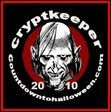Thrill Fiction is proud to present guest blogger Ross Tipograph. His contribution is welcome because Gore Vidal won’t speak to me. The following are Ross’ views and all hate mail should be directed to him.
Or just leave a comment.
Or just leave a comment.
A Nightmare on Elm Street 1984 is the definition of ghoulish.
Let’s begin by first discarding the recent remake, released April 2010, a plague to cinemas around the globe. It was poorly written, with acting performances to make even the least movie-savvy watcher cringe and a script that attempted to rewrite history – the history of a man named Fred, who knows only one true creator: Wes Craven.
In 1984, the first Elm Street
He kills you in your dreams. That was the thought I had to wrap my head around upon my first viewing. It was amazing and impossible and horrifying. By this time, I was already obsessed with Scream 1996 and I knew most of the ‘50s-‘70s classics like the back of my DVD binders. Elm Street was the cherry on top of the cake and oh what a cherry.
It opens with the black and red flickering New Line Cinema logo. It’s also eerily silent until the first moment of Charles Bernstein’s masterful score sets the chilling and original mood. It is an ambient electronic pulse like an alien invasion accompanied by a growing growl and a woman’s choral vocals. Then the image: the Man’s dusty boots, his bag of knives, the shrill piercing sounds of the score grow louder. The sharpening of a knife, the booming title card, a jump in the opening credits with a mock childhood theme that is both crude and scary. Here a movie and a legend are born in the span of one minute. That’s all we need to know what we’re in for.
It’s genius. Throw a bunch of ‘80s (cliché) high school students into the midst of what would be the most harrowing experience of any young (or grown) person’s life – a dream killer. A Nightmare. The students are plucky but deaths are more entertaining. We begin with Tina then Rod then they all start to drop like flies until it’s all up to Nancy Thompson to save the day – after her friends and boyfriend are viciously slashed.
The dream sequences most definitely hold up to today – and to think, it was all without CGI. It was Craven’s brilliant direction that keeps us teetering insanely between dreams and reality, cutting quick to the knifed glove slashing through a sheet, set to the sound of a girl’s scream, or the mechanically over-stretched arms of the villain in a dark alley, or a tongue popping out of a phone’s receiver. There are almost no explanations – except that there is nowhere to hide. It’s very surreal and very unprecedented.
It’s interesting: the sequels came in truckloads, and yet Freddy remained an icon. With the exception of Dream Warriors 1987 the sequels were abysmal. Freddy evolved into comedy and the filmmaking devolved into a poor excuse for stale popcorn. Even Craven’s return to the series, his own New Nightmare 1994 (more of a re-vamp than a sequel, really), poked fun at the Freddy phenomena. There’s no getting around the fact that this character is forever cemented in gold.
For fans of the series, seek out and find Behind the Mask: The Rise of Leslie Vernon, a horror-comedy mockumentary about serial killers from 2006, featuring a cameo from our own dear Robert Englund.
Nine, ten, never sleep again.
Read more Thrill Fiction: Re/Made: A Nightmare on Elm Street
Technorati Tags:a nightmare on elm street, horror films, best 100 horror filmsGenerated By Technorati Tag Generator
BIO
Ross Tipograph is a film buff and Emerson College













